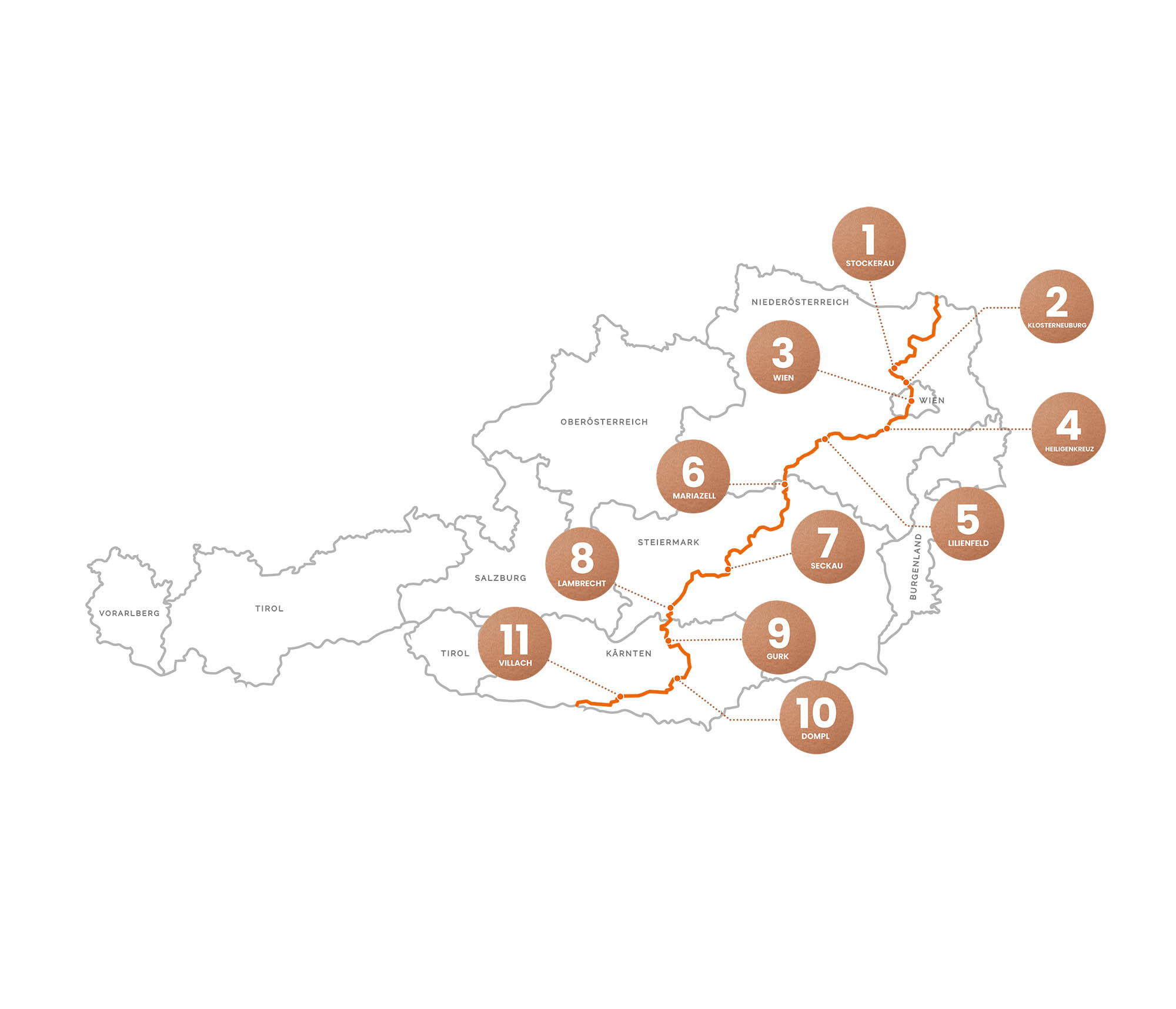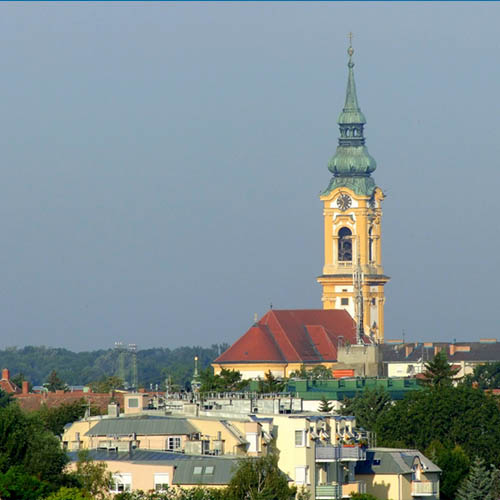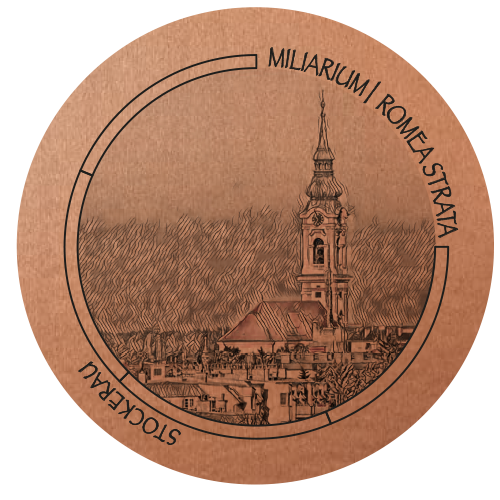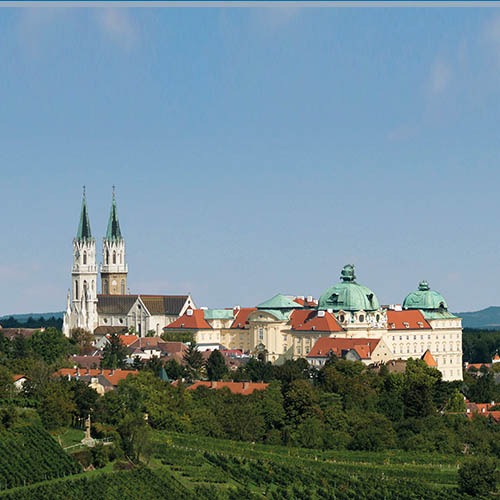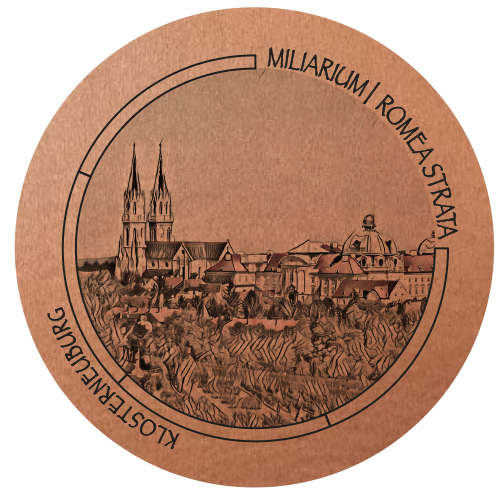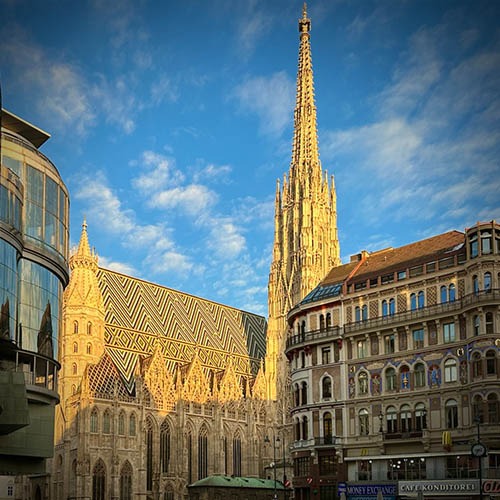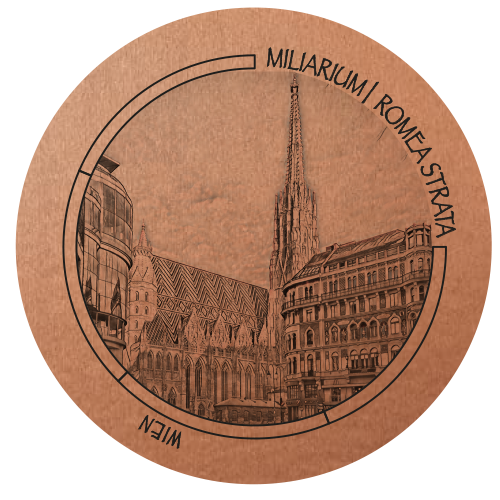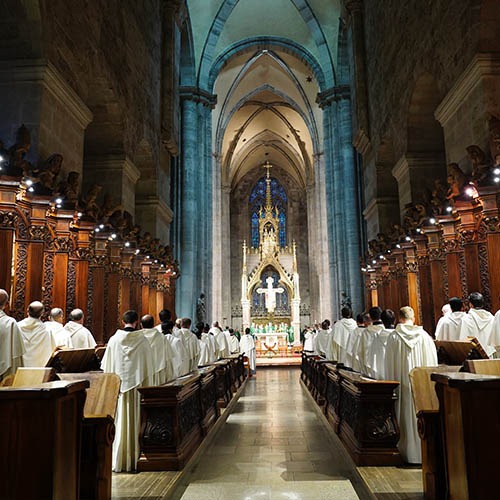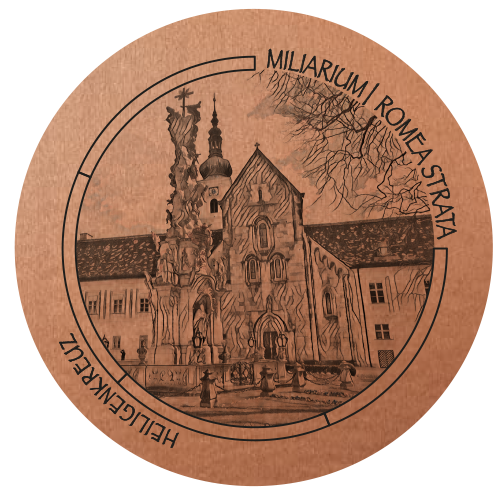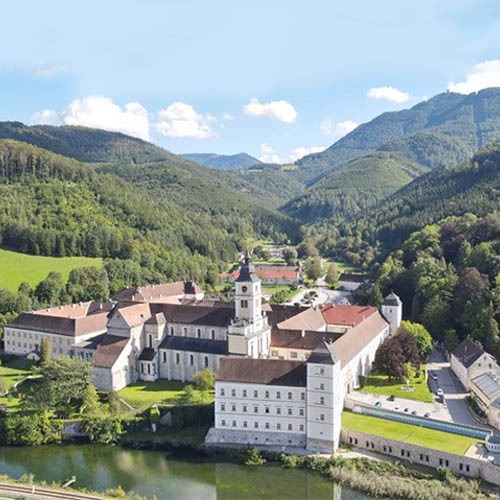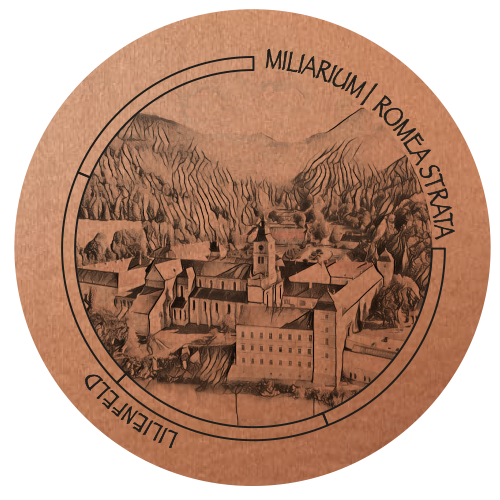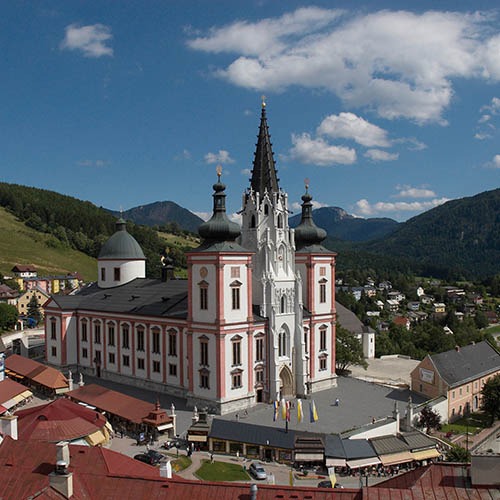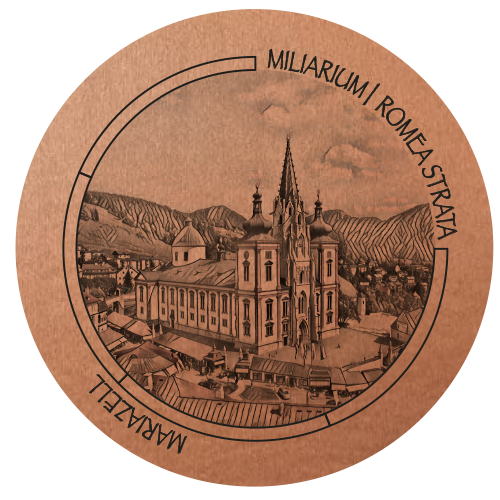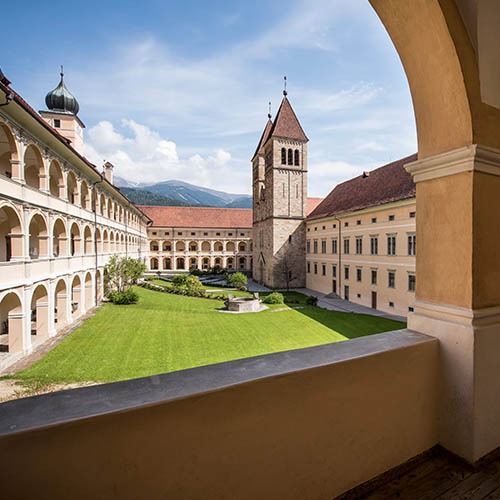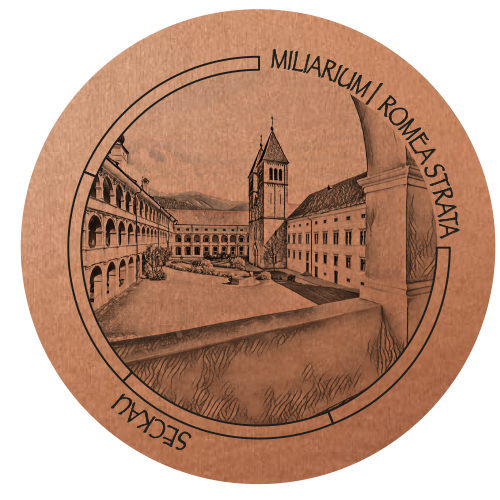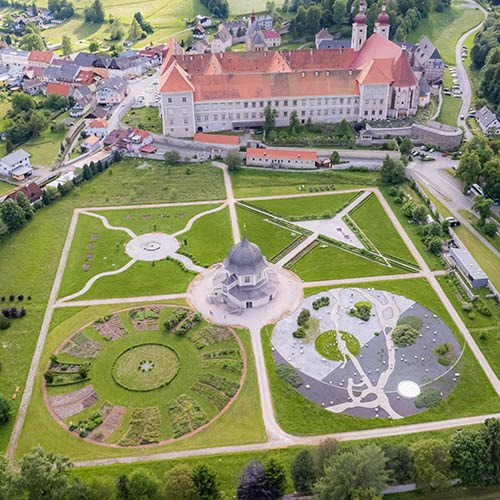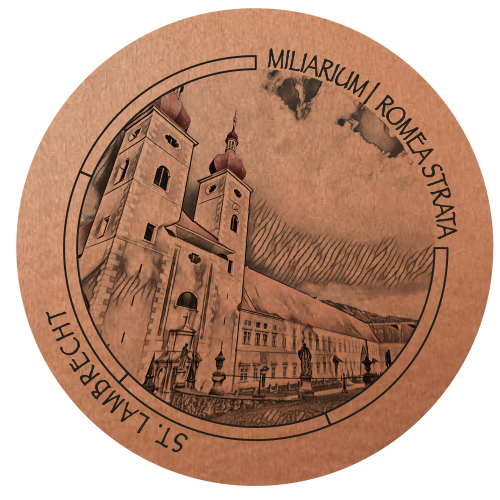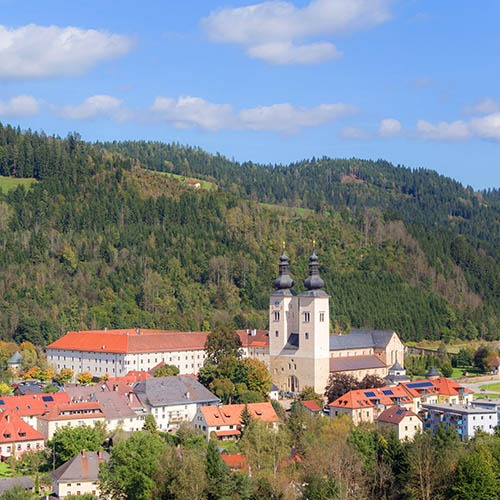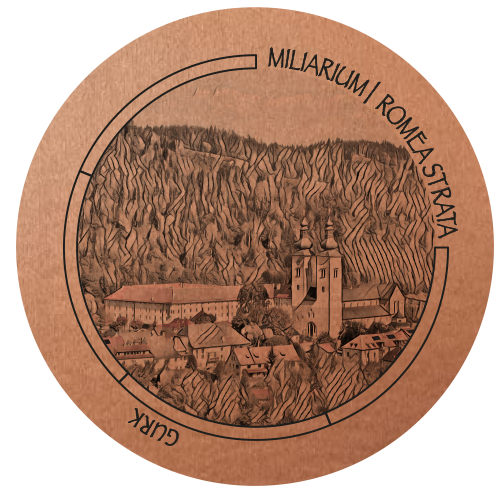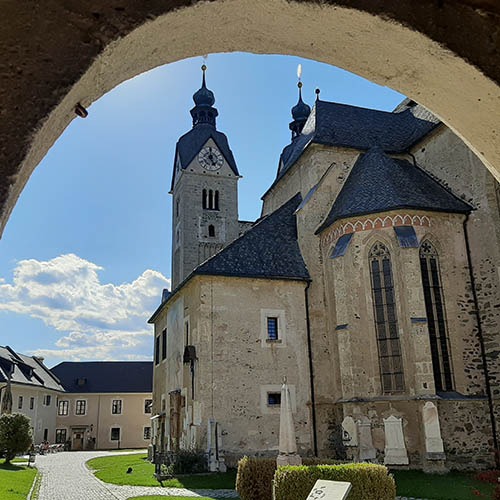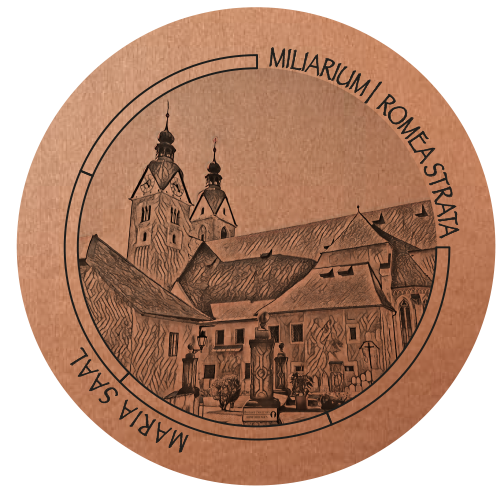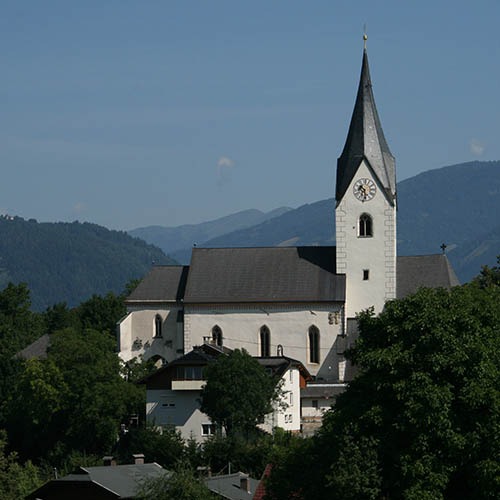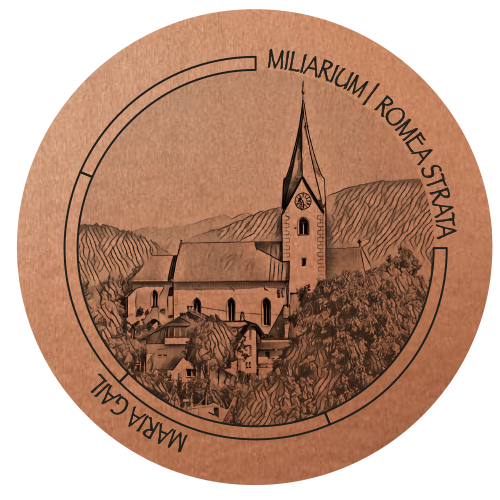Miliarium - Austria
The jubilee sites
Giubileo 2025 | Miliarium - Austria
The Miliarium is a symbolic recognition celebrating a pilgrim’s passage through one of the Jubilee locations along the Via Romea Strata in Italy. Each Jubilee stage has its own unique Miliarium, given as a sticker to be applied to the pilgrim’s credential: a tangible sign of the journey completed and the spiritual path undertaken.
To receive a Miliarium, you must have completed at least two consecutive stages of the Via Romea Strata, either on foot or by bicycle, following the official GPS tracks. It’s not the distance that matters, but the geographical and temporal continuity of your journey. The stamps collected along the way serve as proof of your passage and allow you to obtain the corresponding Miliarium.
After collecting three Italian Miliarium, you can request the final Testimonium, the official document certifying the completion of your Jubilee pilgrimage to Rome. The Testimonium can be collected at St. Peter’s Basilica, in the heart of the Eternal City.
It is not necessary to walk the last 100 km (or cycle the last 200 km) of the Via Romea Strata to receive the Testimonium; what truly counts is the consistency of your journey, its spiritual significance, and the witness gathered stage by stage.
The stages of the Miliarium - Austria
01- STOCKERAU | PARISH CHURCH STOCKERAU – ST. KOLOMAN
The parish church of Stockerau, dedicated to St. Stephen, likely dates back to 1064 and is today one of the largest parishes in the Archdiocese of Vienna, serving around 10,000 faithful. According to tradition, the Irish pilgrim St. Koloman was mistaken for a spy and executed here in 1012 during his journey to Jerusalem. Legend says that the tree on which he was hanged miraculously sprouted anew, a sign of his martyrdom. Koloman was initially buried in Stockerau before his relics were transferred to Melk. Today, the church features an evocative cycle of paintings dedicated to him, created by Adi Holzer in 1986.
Where to receive the Miliarium: Parish Church of Stockerau
Stefanie Kamleitner, Kirchenplatz 3, 2000 Stockerau
Email: pfarrestockerau@pfarrestockerau.at
Phone: +43 2266 62771
How to receive the Miliarium:
Complete stages E3 and E4 of the Via Romea Strata from Asparn to Stockerau.
02 – KLOSTERNEUBURG | AUGUSTINIAN MONASTERY KLOSTERNEUBURG – ST. LEOPOLD
Founded in 1114 by Margrave Leopold III, now the patron saint of Austria, Klosterneuburg Abbey is one of the oldest monasteries in the country. For over 900 years, Augustinian canons have maintained a living faith here, combining community life with pastoral work. Overlooking the Danube, the abbey captivates with its history, art, and spirituality. Among its masterpieces are the Verdun Altar (1181), with 51 enamelled panels depicting the history of salvation, and the archducal hat of 1616, a symbol of its connection to the Habsburgs. Today, Klosterneuburg also houses a contemporary art gallery and Austria’s oldest winery, where tradition and modernity meet. A visit here is a journey through faith, culture, and flavours.
Where to receive the Miliarium: Visitor Reception / Sala Terrena
Stiftsplatz 1, 3400 Klosterneuburg
T: +43 2243 411-212
Opening Hours: May 1st – Nov 15th: 9:00 AM – 6:00 PM; Nov 16th – Apr 30th: 10:00 AM – 4:00 PM
How to receive the Miliarium:
Complete stage E4 and stage HW-22-04 (to be done in the OPPOSITE DIRECTION: from Stockerau to Klosterneuburg).
03 – VIENNA | ST. STEPHEN’S CATHEDRAL (DOMKIRCHE ZU ST. STEPHAN)
A symbol of Vienna and a national shrine, St. Stephen’s Cathedral is Austria’s most important cathedral. Founded in the 12th century and expanded by the Habsburgs, including Rudolph IV and Frederick III, it is a Gothic masterpiece that narrates centuries of imperial and spiritual history. The famous south tower, 136 meters high, was completed in 1433 and was then the tallest free-standing structure in Europe. Today, you can still climb its 343 steps to admire Vienna from above. Inside, it houses precious relics, vestments, altars, and the tombs of Habsburg emperors and dukes, including Frederick III and Rudolph IV. The north tower, never completed, holds the Pummerin, Austria’s largest bell. With its colourful roof tiles and the double-headed eagle emblem, the “Steffl” is the symbol of Viennese faith and identity.
Where to receive the Miliarium: Domshop (Cathedral Shop)
Stephansplatz 3, 1010 Vienna
Opening Hours: Daily 9:00 AM – 6:00 PM
Email: domshop@stephanskirche.at
Phone: +43 1 51552 3563
Website: www.domshop-wien.at
How to receive the Miliarium:
Complete stages HW-22-04 (to be done in the OPPOSITE DIRECTION: from Stockerau to Klosterneuburg) and HW-22-03 (to be done in the OPPOSITE DIRECTION: from Klosterneuburg to Vienna).
04- HEILIGENKREUZ | CISTERCIAN ABBEY HEILIGENKREUZ
Just 15 minutes from Vienna, the Cistercian Abbey of Heiligenkreuz is one of Europe’s oldest monasteries, founded in 1133 by Leopold III of Babenberg. For nearly 900 years, it has been a vibrant spiritual centre, nestled in the Vienna Woods and a landmark for pilgrims, hikers, and visitors. Over 100 monks live here, active in pastoral care and education, and world-renowned for their Gregorian chant: their “Chant” CDs have introduced Latin choral prayer to millions. During your visit, you can discover the abbey church, the courtyard, the well house, and the chapter house, where the last of the Babenbergs rests. Every day, you can participate in solemn prayer, with particularly atmospheric moments at noon and sunset. Heiligenkreuz is a place where silence becomes music and history intertwines with faith, along the paths of the Via Romea Strata.
Where to receive the Miliarium: Monastery Gate (Klosterpforte)
Opening Hours: Monday to Sunday 8:30 AM – 12:30 PM and 1:00 PM – 5:00 PM
Phone: +43 2258 87030
Email: visit@stift-heiligenkreuz.at
How to receive the Miliarium:
Complete the stage from Klosterneuburg to Vienna (stage HW-22-03 IN REVERSE), then from Vienna (St. Stephen’s Cathedral) to Siebenhirten (in the REVERSE direction), with an additional stretch to Perchtoldsdorf (+4 km). Finally, walk from Perchtoldsdorf to Stift Heiligenkreuz/Mayerling (stage 1/5).
05- LILIENFELD | CISTERCIAN ABBEY LILIENFELD
Nestled in the pre-Alpine forests of Lower Austria, the Cistercian Abbey of Lilienfeld is a crucial stop along the Via Sacra and the Via Romea Strata from Vienna to Mariazell. Founded in 1202 by Duke Leopold VI of Babenberg, it houses Austria’s largest collegiate church and a monumental Calvary, recently restored. For over 800 years, the monks have followed the Benedictine rule of “ora et labora” (pray and work), with choral prayer at the heart of their vocation. The abbey has been a destination for kings, emperors, and pilgrims seeking strength and contemplation. Today, Lilienfeld is also a cultural and hospitality centre. Visitors can explore historic areas like the medieval cellarium and the monastic dormitory, participate in events such as the Summer Academy, and taste local specialities in the Abbey Tavern. A place where time stands still, and spirituality intertwines with art and nature.
Where to receive the Miliarium: Monastery Gate and Shop (Klosterpforte und Laden)
Opening Hours: Monday to Saturday: 9:00 AM – 12:00 PM and 1:30 PM – 4:30 PM; Sunday and public holidays: 11:00 AM – 12:00 PM and 1:30 PM – 4:30 PM
Phone: +43 2762/52420
Email: pforte@stift-lilienfeld.at
How to receive the Miliarium:
You must complete stage 2/5 (Heiligenkreuz-Kaumberg) and stage 3/5 (Kaumberg-Lilienfeld).
06 – MARIAZELL | MAGNA MATER AUSTRIAE (GREAT MOTHER OF AUSTRIA)
Visitors to Mariazell are struck by the rich tapestry of languages, peoples, and cultures that converge here. This site holds over 850 years of history, yet it thrives on the shared energy and faith of all Europe. Generations of pilgrims have left their mark: votive treasures, sacred images, and offerings tell stories of their hopes and gratitude. At its heart is the famous statue of the Madonna of Grace, venerated as “Magna Mater Austriae” (Great Mother of Austria), “Magna Hungarorum Domina” (Great Lady of the Hungarians), and “Mater Gentium Slavorum” (Mother of the Slavic Peoples) – a symbol of unity and a guide on life’s journey. Beyond the world-renowned Marian basilica, the entire Mariazell region is dotted with churches, chapels, and places of silence that invite reflection and prayer.
Where to receive the Miliarium: Tourismus Hochsteiermark Infobüro Mariazell (Tourist Information Office)
Hauptplatz 13, 8630 Mariazell
Opening Hours: Jan-Apr: Mon-Thu: 9:00 AM-4:00 PM, Fri: 9:00 AM-2:00 PM; May-Sep: Tue-Fri: 9:00 AM-4:00 PM, Sat: 9:00 AM-3:00 PM, Sun: 10:00 AM-1:00 PM; Oct-Dec (excluding Advent): Mon-Thu: 9:00 AM-4:00 PM, Fri: 9:00 AM-2:00 PM; Advent: Wed-Fri: 9:00 AM-4:00 PM, Sat & Sun: 10:00 AM-3:00 PM.
Email: j.papst@hochsteiermark.at
Phone: +43 3862 55020-22
How to receive the Miliarium:
You must complete stage 4/5 (Lilienfeld – Annaberg) and stage 5/5 (Annaberg – Mariazell), AND the Mariazeller Gründerweg (in the OPPOSITE direction), stage E02 (Aflenz-Kurort – Seewiesen), and stage E01 (Seewiesen – Mariazell).
07 – SECKAU | BENEDICTINE MONASTERY SECKAU
In the heart of the upper Mur valley, the Benedictine Monastery of Seckau is a place of silence and spirituality with ancient roots. Founded in 1142, it was initially home to Augustinian canons and in 1218 became the cathedral of the Diocese of Seckau, a role now remembered by the double name of the Diocese of Graz-Seckau. Today, the Benedictine community lives by the rule “Ora et labora et lege” (Pray, work, and study). The complex houses a highly regarded full-time secondary school, founded in 1931, with the motto “With head, hand, and heart.” Don’t miss: the Romanesque basilica, the miraculous image of Seckau (12th century), the Habsburg mausoleum (16th century), and the pilgrimage church of Maria Schnee on the Hochalm. Despite centuries of change, the monastery remains a spiritual landmark for the entire Styrian region.
Where to receive the Miliarium: Book and Art Shop Kloster Seckau
Marienplatz 1, 8732 Seckau
Opening Hours: Monday to Saturday 9:00 AM – 12:00 PM / 1:30 PM – 5:00 PM; Sunday and public holidays: 10:00 AM – 12:00 PM, 1:30 PM – 4:00 PM.
If the bookshop is closed: Angela Pichler, +43 676 87493231
How to receive the Miliarium:
You must reach Seckau by completing two consecutive stages of the Romea Strata. You can arrive by following the Mariazeller Gründerweg, stage 5 and stage 6, OR, in the OPPOSITE DIRECTION, from Oberzeiring via Gaalergraben, stage 8 and stage 7.
08 – ST. LAMBRECHT | BENEDICTINE ABBEY ST. LAMBRECHT
Located along the Hemmaweg (Way of St. Hemma), between Admont and Gurk, the Benedictine Abbey of St. Lambrecht has been a spiritual and cultural focal point for the Murau region for nearly 950 years. Considered the mother monastery of Mariazell, it is also the starting point of the “Sentiero dei Fondatori” (Founders’ Path). The abbey complex includes a monumental Gothic collegiate church, St. Peter’s Chapel, a Romanesque ossuary, and a Baroque monastic building. Don’t miss the monastery museum, with collections of sacred art, ethnography, and the famous bird museum of Father Blasius Hanf. The abbey garden and the “SCHOOL OF THINGS” meeting centre offer space for events, seminars, and moments of reflection. St. Lambrecht is a place where art, nature, and spirituality meet, welcoming pilgrims and visitors in every season.
Where to receive the Miliarium: Klosterpforte – Information Office – Monastery Shop
Hauptstraße 1 (at the monastery gate), 8813 St. Lambrecht
Email: klosterpforte@stift-stlambrecht.at
Phone: +43 3585 2305 29
Opening Hours: See www.stift-stlambrecht.at
How to receive the Miliarium:
You must complete two consecutive stages leading to St. Lambrecht. You can arrive from Oberzeiring via Teufenbach, following stage 9 and then stage 10 of the Romea Strata. Alternatively, you can start from Gurk via Metnitz, following stage 7 and then stage 6, along the Hemma Pilgerweg. The two options are in opposite directions, but both lead to the sanctuary.
09 – GURK | CATHEDRAL OF GURK – ST. HEMMA
Gurk Cathedral, built between 1140 and 1200, is one of Austria’s most important Romanesque basilicas. Imposing and solemn, it features a twin-tower façade, a wide transept, and a nave with three apses. Beneath the choir lies the famous 100-column crypt, consecrated in 1174, which houses the tomb of St. Hemma of Gurk, a central figure in Carinthian spirituality. Inside, wooden sculptures and reliefs narrate her life and veneration. Next to the cathedral is Gurk Abbey, home to the Gurk Treasury – the diocesan museum of the Catholic Church of Carinthia – and the JUFA pilgrim hotel, which welcomes travellers along the region’s spiritual paths. Gurk is a place that combines art, faith, and hospitality in the heart of Carinthia.
Where to receive the Miliarium: Domladen Stift Gurk (Cathedral Shop)
Hemmaweg 6, 9342 Gurk
Phone: +43 4266 82360
Email: dom.info@dom-zu-gurk.at
Opening Hours: March 1st – Oct 31st, daily 9:00 AM – 5:00 PM; Nov 1st – Feb 28th, Tuesday – Sunday, 10:00 AM – 4:00 PM; Closed Dec 25th and Jan 1st.
Or JUFA Gästehaus Gurk
Domplatz 11, 9342 Gurk
Phone: +43 57 083600
Email: gurk@jufahotels.com
How to receive the Miliarium:
You can complete two consecutive stages of the Hemma Pilgerweg (Way of St. Hemma), part of the Romea Strata. One option is to follow the route from St. Lambrecht to Gurk, via Metnitz (stage 6 and stage 7). Alternatively, you can start from Maria Saal and reach Gurk via St. Georgen/Längsee, along stage 4 and stage 5 of the Hemmaweg. In both cases, the stages must be consecutive and stamped on your credential.
10 – MARIA SAAL | PROVOSTY AND PILGRIMAGE CHURCH MARIA SAAL
The church of Mariae Himmelfahrt (Assumption of Mary) in Maria Saal, in the heart of the Zollfeld plain, is one of Carinthia’s most imposing Gothic religious buildings. It stands in a panoramic position, surrounded by walls, towers, and moats, and is an ancient Marian shrine founded as early as the 8th century by Bishop Modestus. The current late-Gothic church was built between 1430 and 1460, with two massive towers and a tripartite nave. Inside, it houses authentic masterpieces from all eras: the Baroque high altar (1714) with a Gothic statue of the Madonna and Child (c. 1425), a fresco of the Epiphany from 1435, and two late-Gothic winged altars from the 16th century, dedicated to St. George and Arndorf. Maria Saal is a historical and spiritual destination, a landmark for pilgrims and lovers of sacred art.
Where to receive the Miliarium: Cathedral Association and Cathedral Shop
Domplatz 1, 9063 Maria Saal;
Opening Hours: Monday – Sunday: 9:30 AM – 12:30 PM and 1:00 PM – 5:00 PM; Phone: +43 4223 51145 or +43 664 1762441
Email (Cathedral Association President): obersteiner@Sachverstand.tech
Website: www.kath-kirche-kaernten.at/pfarren/detail/C3060/der_modestusladen_gegenueber_dem_dom
How to receive the Miliarium:
You must complete two consecutive stages of the Hemmaweg, in the OPPOSITE DIRECTION to the classic route: from Gurk to Maria Saal, via St. Georgen/Längsee (stage 5 and stage 4).
11 – MARIA GAIL | PILGRIMAGE CHURCH MARIA GAIL
First mentioned in 1090, the sanctuary of Maria Gail, near the Gail River in Carinthia, has been a documented pilgrimage site since 1436. The church, with Romanesque and Gothic elements, was rebuilt in 1606 after an earthquake, taking on its current appearance. At the centre of the majestic high altar is the image of grace: a Madonna and Child dating from just before 1600. Next to it, on the north wall of the nave, stands a precious Gothic winged altar from 1415, with a carved scene of the Coronation of the Virgin and painted reliefs. Among other works, three statues depict St. Mary, St. Barbara, and St. Margaret: artistic testimonies of a long devotional tradition. Maria Gail is today a destination of silence and spirituality, following in the footsteps of pilgrims who turn to the Madonna of the Gail here.
Where to receive the Miliarium: Pension Mosers “Zum Wilden Mann”
18. November-Platz 8, 9500 Villach
Phone: +43 4242 34933
Email: post@moser-pension.at
Website: www.moser-pension.at
Opening Hours: 24/7, as the family operates a self-check-in guesthouse in Maria Gail.
How to receive the Miliarium:
You must complete two consecutive stages of the Mariapilgerweg Kärnten (Carinthian Marian Pilgrimage Way), from Maria Saal to Maria Gail, via Maria Wörth, stage 5 and stage 6.
Need help?
Ask us for the information you need, and we will get back to you as soon as possible




